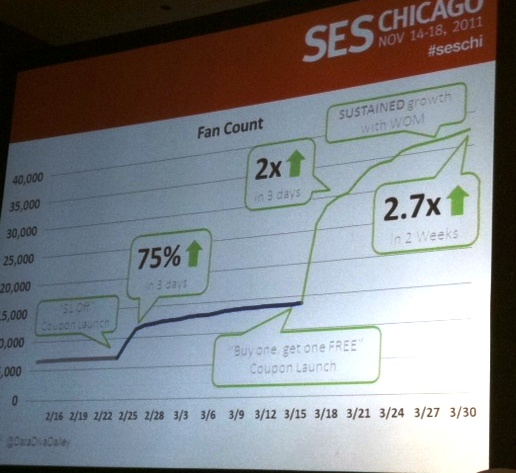Marketers struggling to measure their social media marketing success are not alone; Brafton has reported that just 23 percent of marketers are “very satisfied” with their social analytics tools. At SES Chicago, Buddy Media’s director of analytics and insights, Tami Dalley, shared four measures for brand success in social media, and she showed how these metrics are proving returns from Facebook for a number of her clients.
Dalley stated by reminding marketers in attendance that social value will be specific to a brand. The social goals a company sets out to fulfill will be based on their unique business models and target audiences. Nonetheless, she offered four success metrics that can work in some combination for just about any brand:
- New fans and consumers
- Increased brand awareness
- Revenue and conversions
- (Actionable) consumer insights
Dalley shared success stories for two very different companies that demonstrate how these metrics helped them understand the benefits of their social marketing.
First, she shared data on Pretzel Crisp – a burgeoning snack brand that wanted to use social to make its products better known. Considering its goals, Pretzel Crisp used new fans, brand awareness and revenue as lenses for social success. The company provided two promotional offers to Facebook fans. The first was a $1 coupon. The company quickly saw its fan count grow 75 percent in three days. (She noted that when the company launched this initiative, it advertised the Facebook campaign with other forms of advertising.)
 For its next Facebook promotion (a two for one deal), Pretzel Crisp launched the campaign exclusively on Facebook. The company saw its fan base double in just three days. Beacuse the campaign was launched and promoted exclusively on Facebook, the company knew that social marketing was fueling word-of-mouth referrals that led to further social growth. As such, it attributes brand awareness to Facebook marketing – more fans Liking the page and sharing the deal translated into more consumers knowing what Pretzel Crisp is. There were 90 percent redemption rates for this Facebook coupon, which meant the business also had a handle on social’s ability to drive revenue.
For its next Facebook promotion (a two for one deal), Pretzel Crisp launched the campaign exclusively on Facebook. The company saw its fan base double in just three days. Beacuse the campaign was launched and promoted exclusively on Facebook, the company knew that social marketing was fueling word-of-mouth referrals that led to further social growth. As such, it attributes brand awareness to Facebook marketing – more fans Liking the page and sharing the deal translated into more consumers knowing what Pretzel Crisp is. There were 90 percent redemption rates for this Facebook coupon, which meant the business also had a handle on social’s ability to drive revenue.
The Pretzel Crisp example covers the first three success metrics advised by Dalley, and she says other clients are seeing similar success. In general, she says, shared content produces 48 percent higher orders than other forms of marketing.
For those businesses planning to use social less as a sales driver and more as a reputation builder, Dalley’s first two success metrics still apply, but she also encouraged marketers to pay attention to her fourth success measure: Consumer insights. She referenced an established retailer that noted 40 percent of comments on its Facebook page referenced specific products, and 17 percent of these posts named a trench coat.
As a result of this observation, the retailer put an image of the popular trench coat on its homepage. It also went on to make sure trench coats were on each mannequin and designed a couple more trench coats for its apparel line to great success. This is an example of how “social marketing can prove itself a tool for mining valuable information,” she says.
While Dalley’s success metrics (and case studies) are Facebook-specific, marketers should remember to develop measurable goals for all of their social campaigns. As Brafton reported on Tuesday, 70 percent of marketers believe social marketing (across platforms) is changing the marketing industry.



